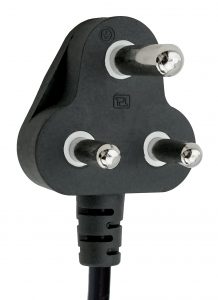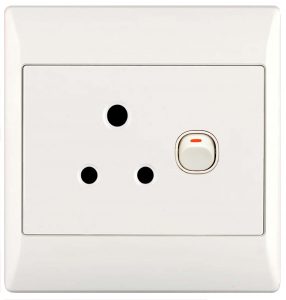TYPE D

 Type D is almost exclusively used in India and Nepal. (Click here for the full list of all countries that use type D)
Type D is almost exclusively used in India and Nepal. (Click here for the full list of all countries that use type D)
India has standardized on a plug which was originally defined in British Standard 546 (the standard in Great Britain before 1947). This 6 amp plug has three round prongs that form a triangle. The central earth pin is 20.6 mm long and has a diameter of 7.1 mm. The 5.1 mm line and neutral pins are 14.9 mm long, on centres spaced 19.1 mm apart. The centre-to-centre distance between the grounding pin and the middle of the imaginary line connecting the two power pins is 22.2 mm. Or, simply put: the earth pin is offset by 22.2 mm. Type M, which has larger pins and is rated at 16 amps, is used alongside type D for larger appliances in India, Nepal and Pakistan. Some sockets can take both type M and type D plugs.
Incidentally, there is an unintended compatibility between type D sockets and various European plugs. Although the centres of the prongs of a Europlug (type C) are closer together (17.5-18.6 mm vs 19.1 mm) than those of a type D plug, a Europlug often fits into a type D outlet without much effort, largely thanks to the elasticity of its pins. However, the plug cannot be fully inserted into a D receptacle, because the prongs are inelastic at the base of the plug and they are longer than the pins of type D plugs (19 mm vs 14.9 mm). This is the reason why type C plugs do not always make proper contact and may cause the socket to spark, which, in some cases, might result in a short-circuit.



